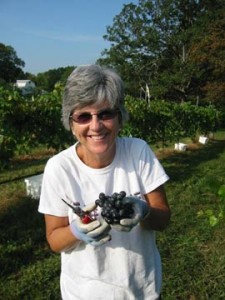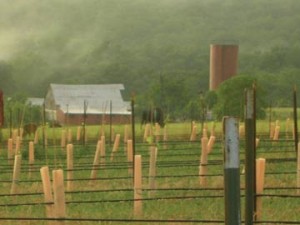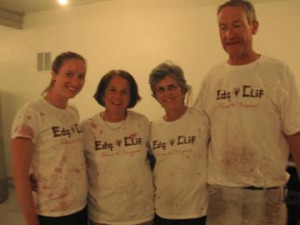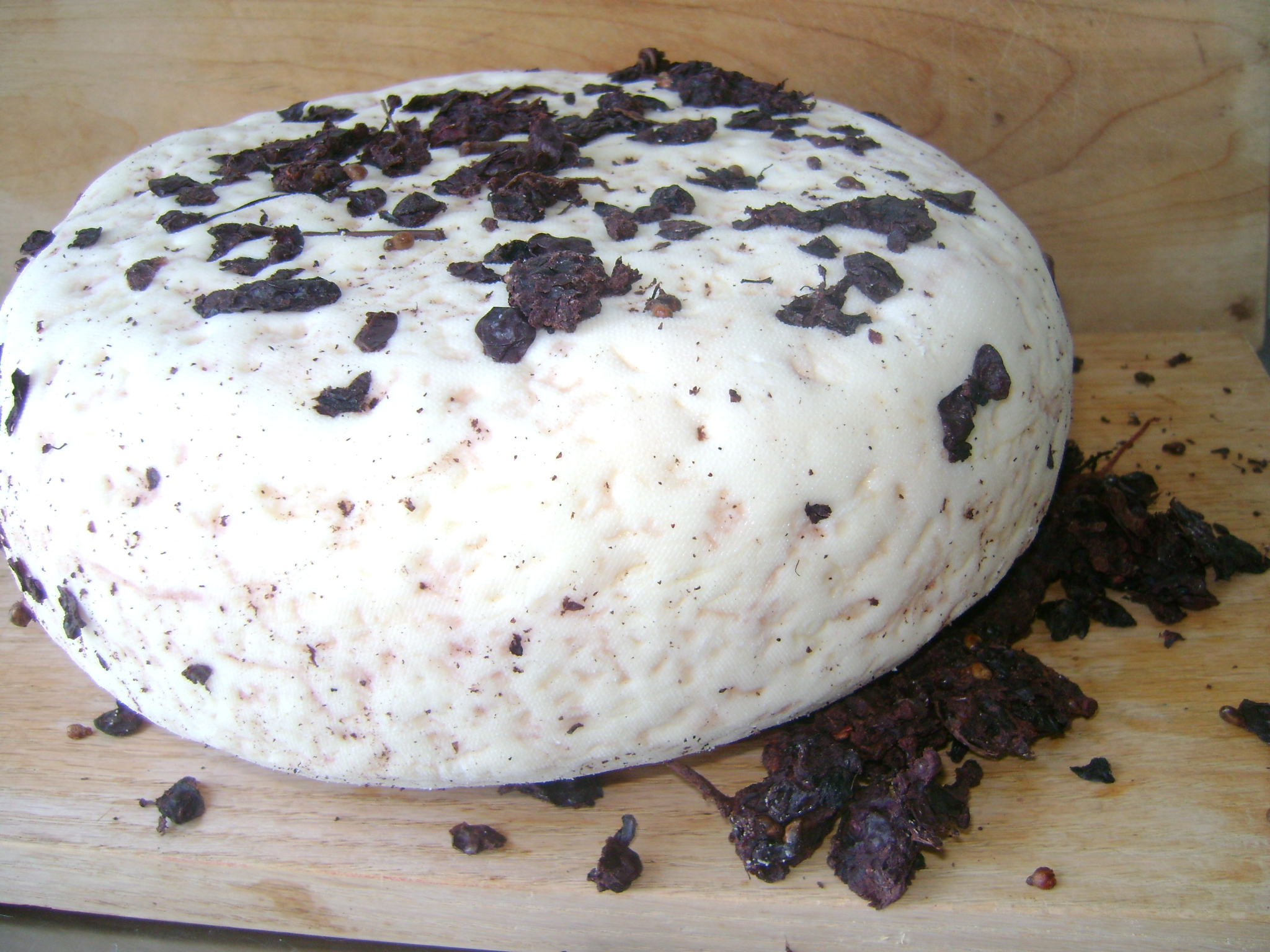Edg-Clif Farms: Chambourcin Specialists
Homepage photo: Cyndy Keesee and Steffie Littlefield.
Edg-Clif Farms & Vineyard, a 550 plus acre property in Potosi, Missouri, is a winery with a unique focus. In 2008, after soil tests revealed that the rich earth was suited to Chambourcin, the owners decided to play their hand to full advantage by planting mainly Chambourcin grapes.
That move quickly paid off for Cyndy Keesee and Steffie Littlefield — the two sisters who run Edg-Clif Farms together with their husbands Girard and Stephen. ‘We planted those little sticks in April 2008 and by September 2010 we had beautiful grapes,” says Cyndy. Then, the family winery began developing numerous styles of Chambourcin wine. Today they bottle nine different styles, from a dry Rosé to a sweet red and everything in-between.
The land’s fertility is a result of the farm’s long history as a prize-winning cattle breeding ranch founded by the sisters’ grandparents, Andrew and Hazel Knapp in 1926 and continued by their parents, Robert and Betty until the 1980s. As the cattle business became tough, the sisters realized they needed to adapt the farm to ensure a sustainable future.
Today, the barn that once housed prize-winning cattle is now the winery. Seven-and-one-half acres of the property is under vines, more than half Chambourcin, but also Vignoles and Vidal Blanc that together produced a total of 2,500 gallons of wine in 2013. After Edg-Clif’s first harvest in 2010, the winery opened to the public in 2011. They’re a wedding venue as well. ‘We feel like in order to sustain the farm we have to be more than just a serious winery,” says Cyndy.
A local herd of bison roam the property as an off-kilter reminder of the farm’s history as a cattle ranch. The animals entertain visitors with their strange grunting noises.
But the focus is on making wine according to a philosophy that Cyndy summarizes as creating quality, approachable wines that are easy to drink and fun. That’s paid off with medals for Chambourcin wines at both the 2012 and 2013 Missouri Governor’s Cup competition.
Edg-Clif Farm’s winemaking success is an achievement considering neither the sisters nor their husbands had any previous winemaking experience. They hired Mark Baehmann, wine consultant and winemaker with Chaumette Vineyards & Winery, to help. Cyndy says they all sat around the table discussing possibilities when Baehmann asked who was going to be the winemaker. The family all pointed a finger at her.
Cyndy admits that back then she felt like a ‘deer in the headlights.” All she knew was what sort of wine she liked. For the first couple of years the winery leaned heavily on their wine consultant who walked them through the winemaking process step by step.
Meanwhile, Cyndy quit her other job and threw herself into the winery full-time, taking advantage of available viticulture and enology educational resources. She continues to attend any classes offered by the University of Missouri’s Grape and Wine Institute and is a member of the Missouri Wine Technical Group. Sister Stephanie affectionately refers these educational endeavors as, “sending Cyndy off to wine camp.”
‘One of things that I find really neat about this industry,” says Cyndy, ‘is it’s a very sharing caring industry so people are very supportive. The big wineries are supportive of the smaller guys and are more than willing to help out and share their expertise.”
Edg-Clif Farm’s winemaker says one thing that helped her understand the winemaking craft was discovering similarities between winemaking and her other passion: cooking. Cyndy compares the timing of picking grapes to deciding when to add certain ingredients to a dish. It’s all about what kind of flavor you want to have, she says.
Cyndy’s educational odyssey has paid off. Last season, she says, the family managed to do almost everything themselves, from harvest to bottling.
Their winery has already won a reputation for making multiple styles of Chambourcin. In fact, says Cyndy, their Chambourcins are respected enough that winemakers who are having trouble with the grape are often referred to Edg-Clif Farms for help.
Their nine different Chambourcins are the result of a harvest that takes 5 to 6 weeks, extending through October. The early harvest grapes are used for a dry, Provence style Rosé, with plenty of fruit and acidity. Cyndy describes the thinking behind making a French inspired blush: “Chambourcin has not been grown as much as Norton or other grapes so most people try to blend whites and reds for a blush. We wanted to create a true, French style rose from a single red wine grape.”
Two more of their Chambourcins are Rosés: a semi-sweet, which Cyndy describes as her go to wine, with pleasant strawberry and watermelon notes. They also have a sweet Rosé – a response to customer demand for a Moscato style wine – with kiwi and peach aromas, but so pale it is almost white, says Cyndy. ‘No time on the skins at all,” she adds.
After the Rosés, they pick grapes for their lighter bodied, semi-dry to sweeter red Chambourcins and then their Holly Berry Red used to make mulled wine. Finally, they get around to harvesting for their two barrel aged dry Chambourcins.
‘You wouldn’t put one of those late season, ugly grapes in your mouth to save your soul. So it’s sort of like making banana bread out of very ripe bananas, rather than the pretty ones. The ugly grapes make the best wine!” explains Cyndy.
Some Chambourcin wines have strong vegetal, herbaceous aromas. Not at Edg-Clif Farms. ‘We have not had that issue and I think that part of that is our soil,” says Cyndy, who adds that ‘herbaceous’ is not a descriptor anyone has ever used for their Chambourcins. For example, she describes their Classic Chambourcin as having ‘some wonderful black cherry notes to it and currant notes to it. It’s very jammy.”
They the Classic Chambourcin in American oak barrels for 12 months with a fermentation in stainless steel tanks. ‘It’s not super heavy bodied because there is no such thing for Chambourcin, but it is really rich,” she adds.
Their Chambourcin Reserve is made by adding French oak chips to their American barrels which brings more vanilla notes to the taste with hints of dark chocolate, says Cyndy.
The winemaking business at Edg-Clif Farms, like the cattle ranch before it, is doing well. Cyndy says the only thing they really lack is a few grape growing and winemaking neighbors.
‘I’m looking forward to a time when there’ll be more viable vineyards and wineries here,” she waxes optimistically.
All photos courtesy of Edg-Clif Farms.








Very interesting! It’s neat to read that some Midwestern wineries are focusing on a “signature” variety……I think in the long run, that makes for better quality wines since the winemaker can build on his/her knowledge base, year after year. Chambourcin is a great variety to work with…..very productive, those large clusters make harvesting a lot of fun, and both the rose’ and the red wine from this variety can be excellent. It does “well enough” for us here in north central Ohio(Wooster), but ripens more thoroughly in somewhat warmer locations. Actually, one of Chambourcin’s offsprings(the Regent variety, from Germany) ripens earlier, and makes a similar, very rich red wine.
Hi Patrick,
Thanks for your informed comment. It would be interesting to know if any other Midwest wineries are really focusing on a particular grape or style of wine.
best
Danny
(using Mark’s long-in)
Hi Danny – Well, off the top of my head I would note Wollersheim Winery in Wisconsin – although they make a lot of different wines, they seem to specialize in Foch and Seyval(their Prairie Fume’).
Nice article about my favorite grape. Chambourcin does well here in the Shawnee Hills AVA of southern Illinois. We have been growing it in our vineyard since 1998 and our buyers have done very well in a variety of styles. The 2006 harvest won Best of Show in the Illinois State Fair Competition. We will have some 2014 harvest available if anyone is interested.
Great article displaying the flexibility of one of my favorite grapes. Kudos to the Edg-Clif family for all of their work!